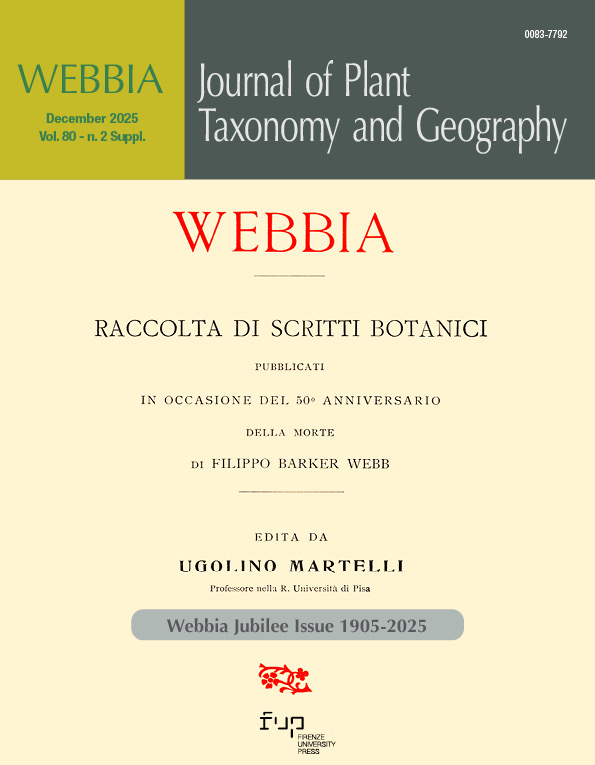Plagiosiphon intermedium (Leguminosae, Detarioideae), a new tree species from the Ngovayang forest in Cameroon
Published 2025-11-17
Keywords
- Africa,
- Endemic,
- Fabaceae,
- Leguminosae,
- Plagiosiphon
- Endangered ...More
How to Cite
Copyright (c) 2025 Xander M. van der Burgt, Eric Ngansop Tchatchouang, Barthélemy Tchiengué

This work is licensed under a Creative Commons Attribution 4.0 International License.
Abstract
Plagiosiphon intermedium Burgt, Ngansop & Tchiengué, Leguminosae–Detarioideae, is described and illustrated. It is a tree, to 34 m high, with a stem to 66 cm diameter. The leaves have (2 –)3–4(– 5) pairs of opposite leaflets, with the lowest pair often sub-opposite. The flowers are unknown. The fruit is a pod, brown, the valves more or less obovate in outline, 7–9.5 × 3.5–4.5 cm, without visible veins outside, short dense hairy outside. Plagiosiphon intermedium occurs in primary rain forest, at 760–870 m elevation. The tree species is endemic to the Ngovayang Massif in the South Region of Cameroon. Three herbarium collections have been made, in an extent of occurrence of only 0.51 km2. Plagiosiphon intermedium is provisionally assessed as Endangered B1(iii,v)+B2(iii,v).
References
- Aubréville A. 1968a. Les Césalpinioidées de la flore Camerouno Congolaise. Adansonia, sér. 28(2): 147–175.
- Aubréville A. 1968b. Flore du Gabon 15, Légumineuses–Césalpinioidées. Muséum National d’Histoire Naturelle, Paris, 362 p.
- Aubréville A. 1970. Flore du Cameroun 9, Légumineuses–Césalpinioidées. Muséum National d’Histoire Naturelle, Paris, 339 p.
- Beentje H. 2016. The Kew plant glossary, an illustrated glossary of plant terms, ed. 2. Royal Botanic Gardens, Kew.
- Burgt X.M. van der, Newbery D.M., Njibili, S. 2021. The structure of Leguminosae-Detarioideae dominant rain forest in Korup National Park, Cameroon. Plant Ecology and Evolution. 154(3): 376–390. https://doi.org/10.5091/plecevo.2021.1879
- Droissart V., Lachenaud O., Dauby G., Dessein S., Kamdem G., Nguembou KC., Simo-Droissart M., Stévart T., Taedoumg H. & Sonké B. 2019. Mine versus Wild: a plant conservation checklist of the rich Iron-Ore Ngovayang Massif Area (South Cameroon). Plant Ecology and Evolution. 152(1): 8–29. https://doi.org/10.5091/plecevo.2019.1547
- GBIF.org (2025), GBIF Home Page. Available from: https://www.gbif.org [Retrieved 16 Aug. 2025]
- Gonmadje C, Doumenge C, Sunderland TCH, Balinga M, Sonké B. 2012. Analyse phytogéographique des forêts d’Afrique Centrale: le cas du massif de Ngovayang (Cameroun). Plant Ecology and Evolution. 145(2): 152–164. https://doi.org/10.5091/plecevo.2012.573
- Harms H. 1897. Leguminosae. In: Engler A, Prantl K. (Eds.), Naturlichen Pflanzenfamilien Nachträge I.: 190–204.
- Harms H. 1899. Leguminosae africanae II. In: Engler A. (Ed.), Botanische Jahrbücher fur Systematik. 26: 253–324.
- IPNI 2025. International Plant Names Index. Published on the Internet http://www.ipni.org The Royal Botanic Gardens, Kew, Harvard University Herbaria & Libraries and Australian National Herbarium. [Retrieved 1 August 2025].
- IUCN 2012. IUCN Red List categories and criteria. Version 3.1. Second edition. Prepared by the IUCN Species Survival Commission. IUCN, Gland & Cambridge. https://www.iucnredlist.org/resources/categories-and-criteria
- IUCN 2024. Guidelines for Using the IUCN Red List categories and criteria. Version 16. Prepared by the Standards and Petitions Committee of the IUCN Species Survival Commission. Published at https://www.iucnredlist.org/resources/redlistguidelines
- Léonard J. 1951. Notulae systematicae XI. Les Cynometra et les genres voisins en Afrique tropicale. Bulletin du Jardin botanique de l’étatcBruxelles. 21(3/4): 373–450. https://doi.org/10.2307/3666679
- Letouzey R. 1960. La forêt à Lophira alata Banks du littoral camerounais. Hypothèses sur ses origines possibles. Bulletin de l’Institut d’Études Centrafricaines. 19–20: 219–240.
- Letouzey R. 1968. Etude phytogéographique du Cameroun. Lechevalier, Paris. https://doi.org/10.5962/p.296414
- Murphy B, Onana J-M, Burgt X van der, Ngansop Tchatchouang E, Williams J, Tchiengue B, Cheek M. 2023. Important Plant Areas of Cameroon. Royal Botanic Gardens, Kew. 302 pp. https://kew.iro.bl.uk/concern/books/c056b5cb-b146-4509-b98b-a7f5dd49517e
- POWO (2025). Plants of the World Online. Facilitated by the Royal Botanic Gardens, Kew. Published on the Internet; https://powo.science.kew.org/ [Retrieved 16 August 2025].
- Shorthouse DP. 2010. SimpleMappr, an online tool to produce publication-quality point maps. Retrieved from https://www.simplemappr.net [Accessed January 19, 2025].
- Quattrocchi U. 1999. CRC World Dictionary of Plant Names: common names, scientific names, eponyms, synonyms, and etymology. Vol. 3. CRC Press.


